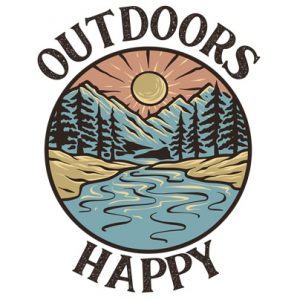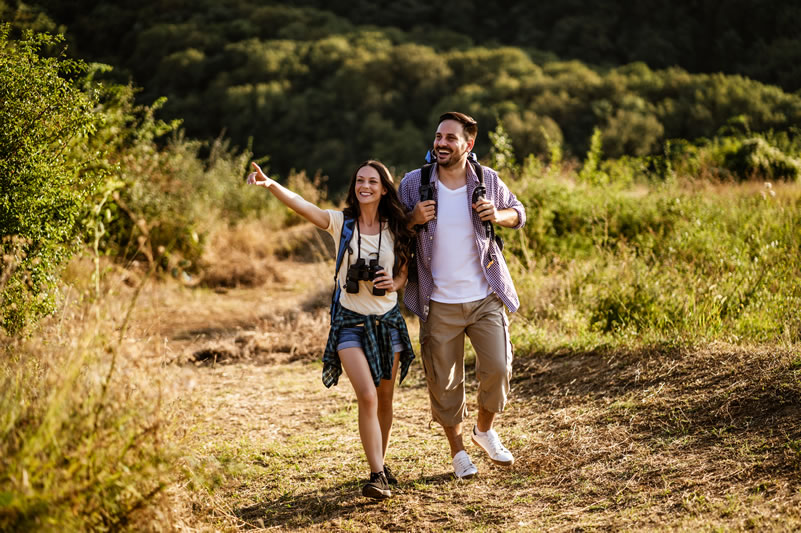Considering both walking and hiking involve walking, it’s natural to assume that they are one and the same thing.
There are though very distinct differences.
So, what are the differences between hiking and walking?
Although you need to walk to go hiking, you don’t need to hike to go walking. A walk is along a level, often flat surface, such as a footpath or street. A hike usually involves following a trail in nature, with hiking gear, that can include inclines and uneven footing surfaces.
To settle this long running debate, we’ll investigate the reasons, provide an explanation and help you decide what may be the best option for you.
What is walking?
I’m not going to explain what walking is. We know of course. Place one foot in front of the other, in a straight line, with balance!
What this section will explain are what characteristics usually only apply to walking. We will then look at hiking in the next section, which should help show you the differences between them.
Walking is usually along a flat, established, and steady surface and can be done at anyone’s pace without any over-exertion. When we say ‘we are going for a walk’ we generally refer to this as a walk to the grocery store, a walk in the park, a walk along the beach etc.…
What is hiking?
Hiking involves walking along a natural trail. It is used as a form of exercise and as a way to get closer to nature. It is a physically strenuous exercise, which has been shown to raise levels of endorphins. Hiking can be done on a flat or mountain terrain.
Images of hikers conjures up mountain or wilderness scenery, lofty views across beautiful natural landscapes.
Hikers often will carry backpacks with hiking gear to help them navigate and accomplish the hiking trail, such as water, food, first aid kit and even a tent if the hike is overnight or across a number of nights.
It can be described as being at one with nature.
How hiking compares to walking?

Hiking is a more strenuous form of exercise than walking and is considered one of the best ways to connect with nature. Walking can be done anywhere at any time without plan, preparation, or gear.
Here are some of the other ways hiking compares to walking:
- Exercising every day is important, whether you walk or hike
- Walking and hiking are good for muscle growth and development
- Spending time outdoors is important whether you walk or hike
- Hiking is a great way to be in touch with nature
- Hiking is a good way to relax, relieve stress and focus the mind
- Walking is a great way to explore your own city
- Walking is one of the best forms of exercise for seniors, and helps them enjoy the delights of the outdoors
- You do not need to plan a walk, whereas a hike you need to plan your trail, food, water and any shelter needs
Really though, whether you choose to go on a hike or go for a walk really comes down to your levels of fitness.
Hiking is always considered to be the more strenuous forms of exercise out of the two.
That said as walking is less strenuous, many seniors can walk a lot further than they can hike (not all seniors of course, as some of them can out pace me every day of the week, and twice on Sundays!).
Walking can burn more calories than you think. Walking 5 miles (10,000 steps) will burn off 400 calories. If you went for a long 6-7 hours walk, at a brisk pace, you could burn off 1,600 calories.
For a man this is 64% of your recommended daily calorie intake, and for a woman this is 80% of your recommended daily calorie intake!
What is classed as a hike?
Hiking is a fun activity to do with a group of friends or a loved one.
You can take a hike in the woods or the top of a mountain. But a hike is generally nature based.
Everyone has a different view on what a hike is. Is it walking up a hill, walking through the forest, up a mountain or across unmarked wilderness?
In my opinion a hike is where you put on a backpack with supplies and essentials, go travelling to a planned trail, enjoy the outdoors and nature and essentially go ‘off-road’.
Hiking across boulders, streams and the unforgiving steep and steady incline of small mountains is all part of the fun. It’s strenuous, exciting, makes many of us happy – and it certainly is not just a walk.
Are more calories burned when walking or hiking?
There are 400 calories burned for every 5 miles of walking, or 10,000 steps, which will take on average 1 hour and 40mins. Hiking can burn up to 900 calories per hour. A full day hike can burn as much as 5,250 calories.
Therefore, supplies such as food and water are essential on a hike. Dehydration and hunger, when burning this number of calories, can set in very quickly!
When does a walk turn in to a hike?
I think the moment you go off the beaten track. Away from parks, city centers, strolls around the block and prepare for a more exhilarating trek across the wilderness.
I guess it could be hard for a walk just to sporadically turn in to a hike. A hike is often planned for and generally requires essentials.
You don’t all of a sudden reach an invisible marker or threshold, whether in distance or number of steps, that instantly turns your walk in to a hike.
And to go off hiking unprepared is never a wise move. You need supplies and need to take precautions, and of course – the right footwear!
What gear you need for hiking

When it comes to the perfect happy hike, you’ll need to make sure you are wearing the right gear and taking along the right essentials.
Hiking can be done with the bare minimum, but why make it extra hard on yourself.
There’s gear that will make the hike more comfortable, and essentials in case they are needed.
Here are just some of the items to take with you on a hike:
- Hiking shoes or boots, depending on the terrain – ankle support is required for lots of uneven surface trails
- Backpack
- Food and water for the duration of your hike, plus any extras for emergencies
- First aid kit and medical suppliers
- Flashlight or head torch
- Take a knife
- Mobile phone – fully charged
- Top Tip: Download your hiking trail to your cell phone whilst you have connection – this means it is always with you on your trail, even if you have no data signal available
- Power Bank – if you have an emergency and your cell phone has run out of battery, this could make all the difference in the world!
- Remember your cell phones’ USB power cable. It’s no good having your cell phone, and power bank, and no power cable to charge your device!
- Tent and sleeping bag if you are planning an overnight hike
As well as the essentials and the right gear, it’s important to know your limits. The National Park Service has a great guide on staying safe, and hiking smart. They write specifically for the National Parks, but it makes sense no matter where you hike.
What gear you need for walking
The great thing about walking is it requires little planning, preparation or essentials.
If you are planning a walk across several hours, then you will need to take many of the items listed in the ‘What Gear You Need for Hiking’ section.
If though you are only planning a short walk – less than 5 miles then a good pair of walking shoes, and a flask or bottle of water should be all you need.
Check the weather before you travel. Weather in the U.S. can change pretty quickly, as we all know, so plan ahead in case waterproof clothes or even an umbrella is needed.
A light-weight backpack to carry some of your essentials in would be useful too.

